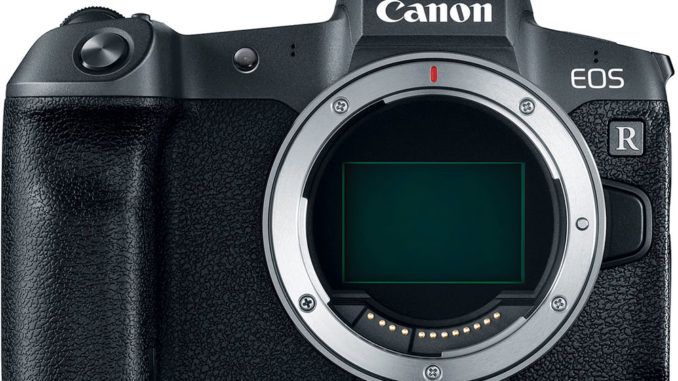
Canon EOS R is Official! Here’s the info..
UPDATE: I have researched more into the specs as when I wrote this it was 2AM. After a day of looking over the specs I SAY WAIT! Read this report HERE.
So the first Canon SERIOUS Mirrorless camera is NOW OFFICIAL and for what this will cost, it seems very nice for those who are Canon fans. Yep, there are some flaws but for the size, and what I feel will be a decent price, there are features here you do not get anywhere else. With a new “RF” lens mount and a slew of new exotic glass, the new Canon EOS R looks really good for video, vlogging and even beats the 6DII for video and photo use. With the new lenses like the updated 50 f/1.2 and 28-70 f/2 Canon is seemingly trying to launch with what may be the coolest lenses ever for a new mount and system (UPDATE, they are costly). The mount has a 54mm Diameter and a short 20mm flange distance. This camera, as all mirrorless will also be yet another solution for shooting Leica M lenses, once adapters are made. With super awesome low light focusing at EV -6 and native ISO up to 40,000, just add the 50 1.2 and you are set for those night time low light shoots. (My MAIN shooting conditions)!
The cons? Single card slot, no IBIS and a MASSIVE DEAL BREAKING 1.8 CROP for 4K shooting. Booooo. But hey, if Canon have EVERYTHING in what should be an under $2000 body, then no one would be buying their cinema cameras or even higher end DSLRs. So, it is what it is. It will either work for you or will not.
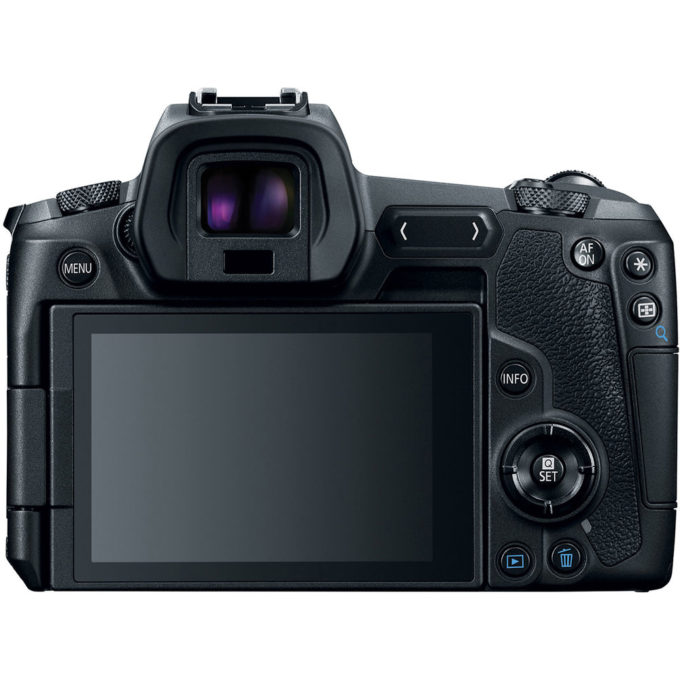
Here are some details from B&H Photo who will be taking pre orders starting on September 12th. (pre order link)
The first step in Canon‘s mirrorless evolution, the EOS R pairs a redeveloped lens mount and updated full-frame image sensor for a unique and sophisticated multimedia camera system. Revolving around the new RF lens mount, the EOS R is poised to be the means from which to make the most of a new series of lenses and optical technologies.
Focusing on the camera itself, the EOS R features a high-resolution 30.3MP full-frame CMOS sensor along with a DIGIC 8 image processor. The combination of these technologies offers a wide sensitivity range up a native ISO 40000, fast continuous shooting to 8 fps, and UHD 4K30 video recording. In addition to imaging, the sensor also facilitates an advanced Dual Pixel CMOS AF system, which uses 5655 selectable points for quickly and accurately acquiring focus. This focusing system is also sensitive down to EV -6 for working in impressively dark conditions. The AF system is also perfectly matched to the UHD 4K video recording capabilities, which are also rounded out by Movie Digital IS to minimize camera shake, built-in Canon Log gamma for a greater dynamic range, and 4K 10-bit 4:2:2 output over HDMI for even greater color control.
Beyond the performance attributes, this camera has been designed from the ground up and features a high-resolution 3.69m-dot OLED electronic viewfinder for clear and bright eye-level viewing. Conversely, a rear 3.15″ 2.1m-dot LCD touchscreen is also featured, and has a swivel design to suit working from high and low angles. Also catering to the tactile cravings is a Multi-Function bar, which is customizable for intuitively adjusting shooting settings. And as a camera built to withstand the toughest environments, the magnesium alloy body is dust and moisture-sealed.
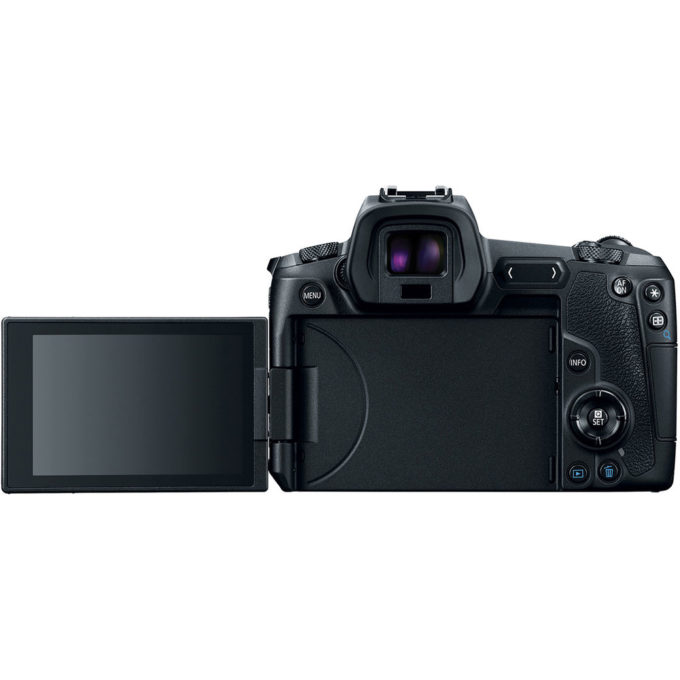
- Canon RF Lens Mount
- Beginning with a new lens mount, the EOS R is the first camera to support Canon’s line of RF-mount lenses. This mount is characterized by its wide 54mm diameter and short 20mm flange-back distance, which promotes the ability to design lenses that are both faster and smaller than their SLR equivalents. The mount also incorporates a 12-pin electronic contact system for more sophisticated autofocus and image stabilization capabilities. This mount design also lends full compatibility to existing EF and EF-S-mount lenses via an optional EF-EOS R Mount Adapter.
- 30.3MP Full-Frame CMOS Sensor and DIGIC 8 Image Processor
- A large 30.3MP full-frame CMOS sensor is featured and serves as an ideal balance between high-resolution output, low-light performance, and high-speed capabilities. When paired with the DIGIC 8 image processor, the EOS R affords a native sensitivity range of ISO 100-40000, which can be expanded to ISO 50-102400 for working in a variety of lighting conditions. Quick continuous shooting to 8 fps is also supported for photographing moving subjects.
- Dual Pixel CMOS AF
- Dual Pixel CMOS AF offers smooth and fast focusing performance in a similar manner to how a camcorder acquires focus. This system integrates two separate photodiodes within each pixel to provide a broad and dense network of 5655 phase-detection gathering elements across a majority of the image sensor to reduce focus hunting for faster, more direct control of focus placement. When working with still imagery, this focusing system works to acquire focus quickly and accurately, making it ideally suited to shooting and tracking moving subjects so that critical focus is attained with each shot. When shooting video, a Movie Servo AF mode offers smooth and natural focusing when changing from different subjects or different distances within the scene, as well as the ability to specify tracking sensitivity, AF speed, and Face Tracking priority. Benefited by the Touch AF system, rack focus is possible simply by touching elements within the scene on the touchscreen in order to change focus in an intuitive manner. Subject tracking in movies is also heightened due to the Dual Pixel CMOS AF system’s ability to recognize subjects and maintain focus when working within changing or cluttered scenery. Additionally, the focus system is sensitive down to EV -6 for working in truly low-light conditions with accurate AF capabilities.
- UHD 4K Video Recording and Canon Log Gamma
- Designed for multimedia image-maker, the EOS R supports UHD 4K (3840 x 2160) resolution recording at up to 30 fps at 480 Mb/s, along with Full HD 1080p shooting at 60 fps and HD 720p at 120 fps for slow motion playback. When recording in-camera, 4K video has 4:2:2 sampling and 8-bit color depth, a 4:2:2 10-bit clean output in ITU-R CT.2020 is possible when using an external recorder.
Integrated Canon Log also allows users to capture flat images with an improved dynamic range of 800%, or 12 stops. This function makes it easier to match cameras in post-production as well as provides the most latitude and potential for color grading. For monitoring, a View Assist function is available, which emulates a graded look for more accurate viewing on the camera’s LCD.
Audio can be recorded using the on-board stereo microphone or an optional external mic can also be used via the 3.5mm mic jack.
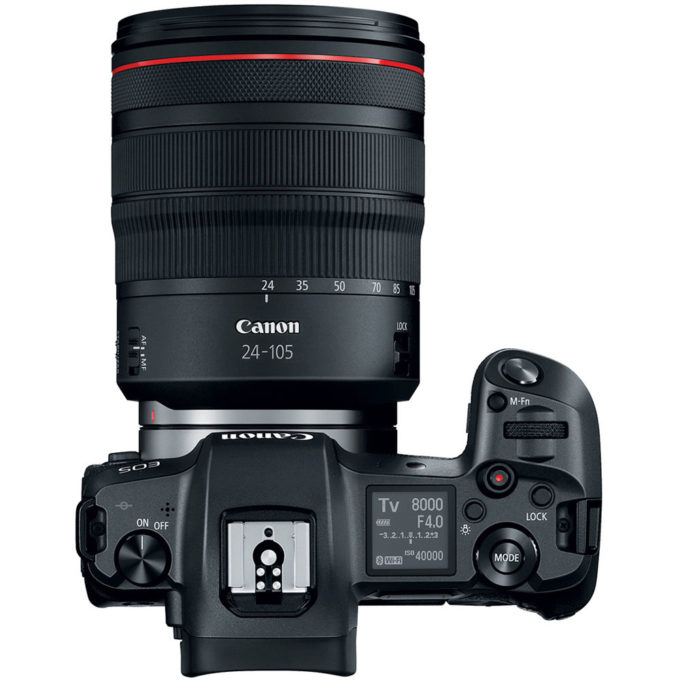
- Dual Pixel RAW
- First introduced with the EOS 5D Mark IV, Dual Pixel RAW allows photographers to record all the information the sensor’s unique pixel architecture can deliver, providing a way for fine adjustments to be made after the image is taken. These adjustments include focus fine tuning that can help you ever-so-slightly adjust the focus point to bring out extra details, shift bokeh around for improved composition, and reduce the impact of ghosting on your photos. This requires the use of Canon’s Digital Photo Professional software.
- Body Design
-
- Integrated 3.69m-dot OLED electronic viewfinder has 0.71x magnification and affords a bright and clear means for eye-level viewing.
- Rear 3.15″ 2.1m-dot LCD features a swivel design for easier use when working from high, low, and front-facing angles. It is also a touchscreen for intuitive control over shooting, playback, and menu navigation controls.
- Customizable Multi-Function Bar is located near the viewfinder on the rear of the camera, and can be set to control four functions using right, left, slide, and press movements. It can be used to adjust ISO or white balance, to check focus/display focus info or AF modes, change to movie shooting modes, use flexible-priority AE, or be customized for other functions.
- Top panel incorporates a dot-matrix LCD, which provides quick access to important camera settings.
- One SD memory card slot featured, and supports the UHS-II protocol for faster read and write speeds to better support 4K video recording and fast continuous shooting.
- Magnesium alloy body design is lightweight, durable, and features dust- and water-resistant seals for use in a variety of weather conditions.
- Built-in Wi-Fi and Bluetooth connectivity enable wireless sharing, control, and image transfer with a compatible smart device via the Canon Camera Connect app, which also supports geotagging your files using your mobile device’s location data.
- Included LP-E6N rechargeable lithium-ion battery provides approximately 430 shots per charge, and in-camera charging is supported via the PD-E1 USB Power Adapter. This camera is also compatible with the LP-E6 battery, however is not supported for in-camera charging.
- Other Camera Features
-
- Digital Lens Optimizer helps to minimize the appearance of various optical aberrations in-camera, including diffraction, for cleaner image quality.
- Multi shot noise reduction technology records four sequential exposures and then combines them in-camera to produce an image with smoother tones and lower noise to suit long exposure images.
- Images can be saved as Compact Raw (C-RAW / .CR3) files, which offer smaller file sizes for faster post-processing.
- Language Support: English, German, French, Dutch, Danish, Portuguese, Finnish, Italian, Ukraine, Norwegian, Swedish, Spanish, Greek, Russian, Polish, Czech, Hungarian, Vietnamese, Hindi, Romanian, Turkish, Arabic, Thai, Simplified/Traditional Chinese, Korean, Malay, Indonesian, and Japanese.
There ya go!
MORE…


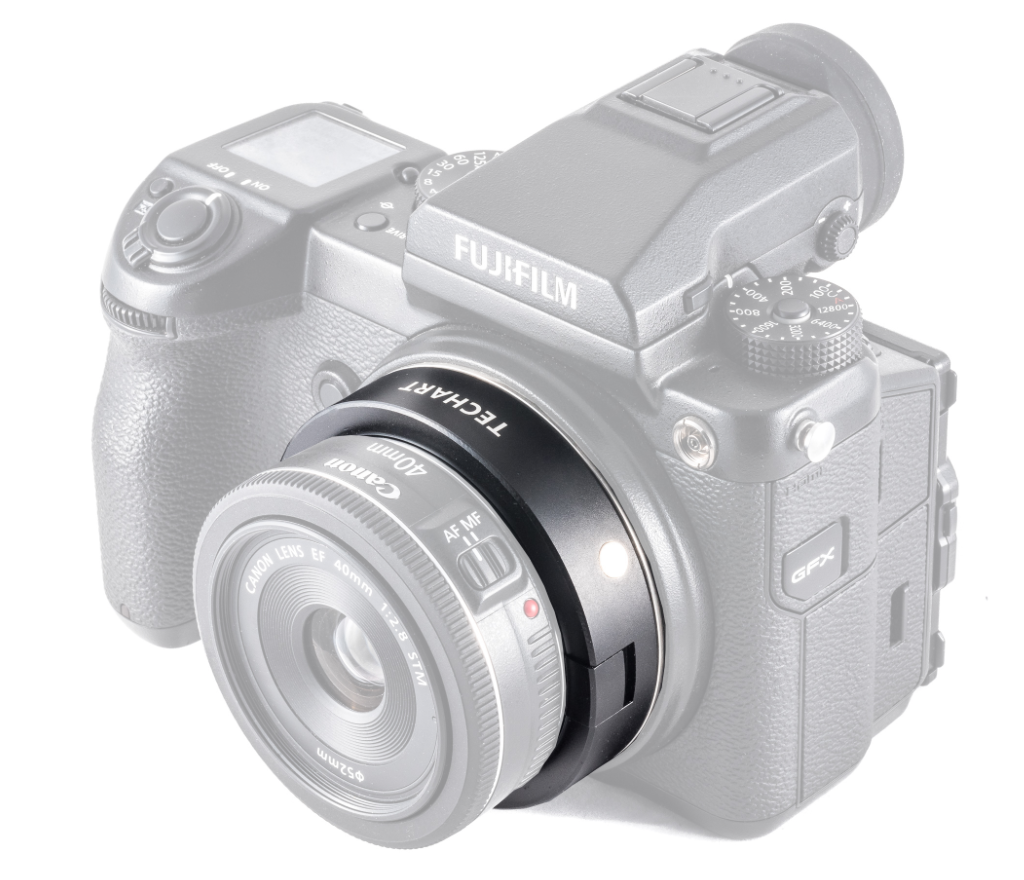
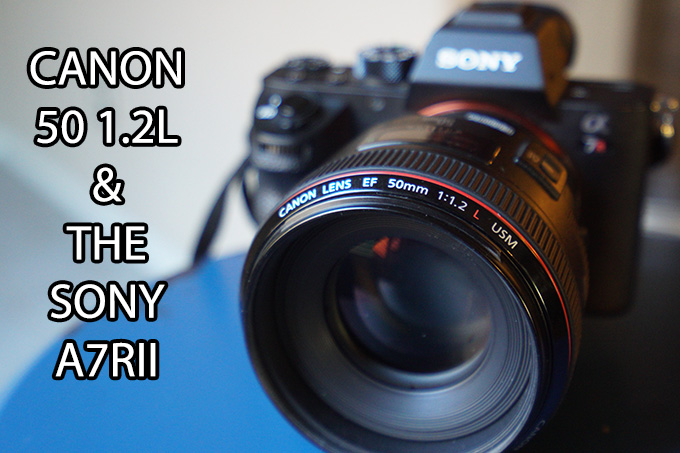

I watched a demo of the Canon EOS R and quite frankly it left me cold. Far too many “options” and “personalisations”, and new lenses to buy. Photography, I believe, should always about simplicity and capturing the moment, not about multiple choices. I do understand the importance of innovation in digital photography, yet I can’t help but feel that it turns the camera at you, the photographer, not the other way around. Maybe I’m not getting my point across clearly enough and I accept that, but remember that technology will soon overtake this model, and what happens then?
Radiohead said it best ‘you do it to yourself and that’s what really hurts!’ – no IBIS, only three lenses and one card slot with the Nikon. I mean all they have to do to get it right is read your posts it’s all there for them – unforgiveable! I buy secondhand and cheap and resist the Carousel.
Super 32 video has it’s pros and cons. The Sony A7Riii has two options for video – full-frame, 5K oversampled, and super-35 direct. Full frame video has lower noise and low light capability, while Super-35 is sharper. Both are 4,2,0 color sampling, but record 4,2,2 8-bit to an external recorder. There is no arbitrary 29 minute clip limit with an external recorder, bypassing the limit found in all MILC’s and DSLR’s except the Panasonic GH5.
Personally, I favor the longer reach of the smaller format for the kind of things I video – classical concerts and student auditions. 4,2,2 sampling has little effect on color, but a tremendous improvement in resolution. 10-bit depth would be nice, but mainly if you make intensive grading adjustments.
The big question is if Dual Pixel CMOS AF will work in 4k video?
Yep, not sure why these companies drop the ball. IBIS is a much wanted feature and yet Canon did not implement it. Not all want or need it but it should be expected. I do like the Canon slid in ND filter with the adapter though. But each camera has a weakness. All of them. No one will ever make the perfect camera unless that camera company only makes ONE model, which maybe they should.
They ALL have weaknesses. I have pointed them out on each, even the Sony A7III has weaknesses. The Canon offers ONE things that thousands have been asking all of these companies for. A swivel screen. Believe it or not, these cameras are being used more for VIDEO than photos today. Canon offers the only full frame mirrorless to offer a swivel screen. Also, their dual pixel AF beats Nikon and Sony. Sony gets close but Nikon lags behind here. Most video users I know of prefer Canon’s color as well. The Nikon offers nice ergonomics and control, a beautiful EVF and LCD but lags compared to Canon and Sony in AF and battery life. None are perfect and if you have Nikon lenses, one should go with Nikon if they want a full frame mirrorless. Have canon glass? Go canon. Want the Sony? Go for Sony! None are bad, none are perfect. People should go with what floats their boat but yes indeed, A TON out there have been waiting for a full frame mirrorless with a swivel screen, and Sony and Nikon just do not offer it. Ive already hear from a few who say that’s why they are going Canon. So yes, it offers a few things you can not get from Sony. The Sony offers things you can’t get in the Canon or Nikon and the Nikon offers a higher res EVF and LCD over and better IBIS over the Sony (and the Canon has NONE)!, and a couple of other benefits. Sony offers a huge range of native glass, and a maturity to their system. All have pros and cons and I listed them out the other day.
Have to say this really looks strong. The new lenses are the selling point. I use a M10 and a Nikon D500 currently, but i can see me down the road getting rid of the Nikon and moving to this. No rush for me because i’m happy with what i have… but that new glass looks amazing.
Please describe the weaknesses of the Nikon mirrorless that Canon exploits. An articulating screen and DPAF is all I see. We still don’t really know how well the autofocus system of the Nikons work. I know there were some complaints from wildlife and sports shooters. But the video autofocusing looked pretty good. Plus, Nikon has full-frame 4k, not cropped. Also, the weather sealing looks a lot better on the Nikon and the XQD card has much better performance and reliability than a UHS-II.
I just wonder why Nikon gets bashed for having a single card slot, but Canon seems to get a pass for it and for not having IBIS. If Nikon had left out IBIS, the Internet would have melted.
If you are invested in Canon glass, you stay with this camera. If you are invested in Nikon glass, you stay with Nikon. If you have no investment in either, you have lots of options.
As a long time Minolta and Sony shooter I see a lot of what I experienced when the first A7 came out. I wanted a small body. And I wanted to use all my Minolta and Sony (both A-mount glass; I had a great collection), so I bought the A7R.
I got the adapters and began shooting.
I also bought a lot of very fast R-mount lenses from Leica. Rather ‘cheap’ and great IQ.
Nowadays use mostly the Gm glass. The Leica’s and the A-mount glass is too big and heavy. They GMs are so good that the other lenses are sold or are collecting dust. Except for the Minolta 200mm f/4 Macro and the Minolta 200mm F/2.8 I sold all my A-mount glass.
I hope Sony is bringing a 200 f/2 or f/2.8. The Minolta gives very, very nice pictures, but is rather slow (focussing) and without Eye-AF.
Bottomline: I think a lot of Canon and Nikon users will at first use their lenses on these mirrorlesssystems, but in the end everyone will buy the mirrorlesslenses. The DSLRlenses are just too heavy and too big.
So beware: Buying these systems is gonna cost you! 🙂
I’m a real fan of the Sony (using the A7Riii now). I like the guts Sony had to go FF mirrorless. Hope they will stay in front. Go Sony, Go!
no I don’t forgive the lack of Ibis I can forgive the
missing card slot,
worse battery life,
missing Eye AF,
no open mount specs for 3. party lenses,
But not the missing Ibis
I was already planning to buy it with the 50mm 1,2 but now I read the body has no Ibis and the new lenses don’t have it either (50 1,2 and 24/70 2 )
I mean we are now in 2018 and since years we take pictures with Sony A7 and other brands with Ibis and now Canon as the last snail even after Nikon presenting this beautiful mirror-less 30 MB full-frame camera with many great things in it but without Ibis … serious???
I have changed to A7R2 3 years ago and have now also a A7R3 coming from Canon and Nikon and they slept for years and now finally both bring mirror-less cameras for + 2000 USD and both brands didnt get it right yet
Cant believe it!!! total disappointment!!!
So I must stay with Sony and hope they will continue improve
Canon’s effort with this new R really exploits the weaknesses of the new Nikon Z. With the R, we might decide to forgive the lack of IBIS, a second card slot and 1st gen Sony battery life for the sake of a superbly implemented auto focus system and those Canon colors are sublime IMO. Not loving that shutter sound though … If I buy it, it’ll be silent running for sure 😉
no Ibis?
can’t believe that
who in the world would buy a new mirrorless for 2000 USD without ibis?